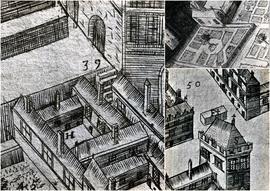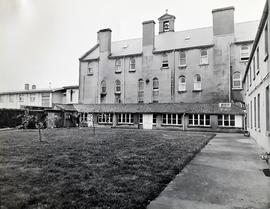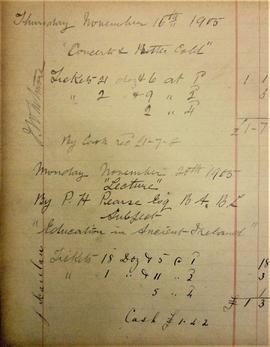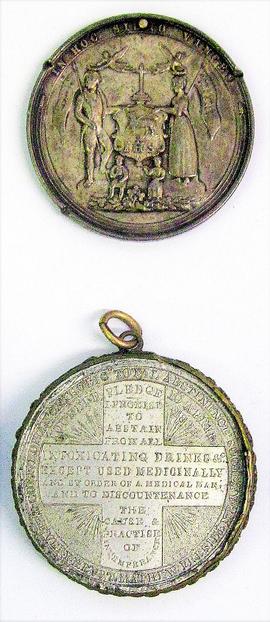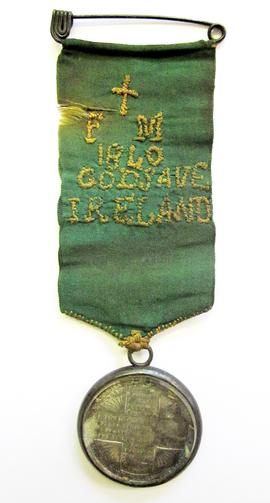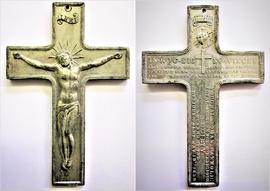Father Mathew Temperance Medal
c.1840-1850
Diameter: 4.4 cm
Silver Medal
Physical description:
• Face (front): Fr. Mathew addresses the kneeling crowd. Outer rim inscription reads ‘May God bless you and grant you grace and strength to keep your promise.
Obverse: Outer edge inscription reads ‘Dedicated to the Very Rev. Theobald Mathew. Centre: ‘Whose / exertions / have laid the / foundation of his country’s happiness / and merited / the admiration / of mankind’.
A green and white ribbon in the form of a crucifix (with pin) is attached.
Total Abstinence Society Medal
c.1840-1850
Diameter: 4.4 cm
Silver Medal
Physical description:
• Face (front): Man and woman on pedestal on which two children are seated. The adults carry a shield surmounted by a cross, with an angel above. The upper part of the shield has a lamb bearing a banner. The man bears a banner with the words ‘sobriety’. The woman bears a banner with the words ‘Domestic Comfort’. Outer-edge inscription reads: ‘In hoc signo vinces’.
Obverse: Cruciform text of pledge. Outer edge inscription reads: ‘Total Abstinence Society, The Very Rev. T. Mathew, President’.
A green ribbon with pin is attached.
Total Abstinence Society Medal
1840
Diameter: 4.4 cm
Silver Medal in Glass
Physical description:
• Face (front): Man and woman on pedestal on which two children are seated. The adults carry a shield surmounted by a cross, with an angel above left of the cross. The upper part of the shield has a lamb bearing a banner. The man bears a banner with the words ‘sobriety’. The woman bears a banner with the words ‘Domestic Comfort’. Outer-edge inscription reads: ‘In hoc signo vinces’.
Obverse: Cruciform text of pledge encircled by title of society, president (Fr. Theobald Mathew), and the date of foundation (10 Apr. 1838).
A large green ribbon is attached with the following embroidered text ‘F ✙ M / 1840 / God Save Ireland’. The ribbon is partially torn. Very careful manual handling is required.
Medal of the Army Temperance Association, India
1862
Oval-shaped silver medal
4 cm x 3 cm
Physical Description:
• Medal of the Soldiers’ Total Abstinence Association in India. The inscription the face reads ‘Watch and be sober’. Inscription the obverse reads ‘The Association Medal for Fidelity India’.
Note: After 1902 the Victoria Memorial Medal was adopted and used by Indian Organisations of the Royal Army Temperance Association as a Two-Year Medal.
Temperance Medal Ribbon
1889
Physical Description:
• A green ribbon with silver crucifix attached bearing the inscription ‘Presented to the Very Rev. Fr. Columbus [Maher] OSFC / President / Feb. 1889’. The ribbon would have been originally attached to a temperance medal. Fr. Columbus Maher OSFC (1835-1894) was President of the Father Mathew Temperance Association attached to St. Mary of the Angels, Church Street, Dublin.



